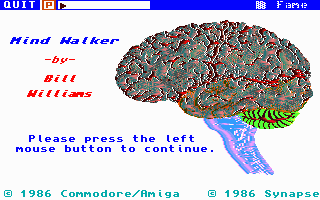
Of those of you who have been following the Amiga Gaming Retrospective so far, probably relatively few were Amiga users when the games I've looked at so far (MarbleMadness! and Crystal Hammer) first came out. Well, Mind Walker (no, not the web browser) dates back further than even I have been using Amigas. This, the one game Commodore ever released for the Amiga, was published in 1986. I got it a few years later, and it has amazed me ever since...more, in fact, each year.
Every once in a while a game comes along that combines just about all the elements of a great piece of entertainment software: features, performance, gameplay, and coherence. As it turns out, Mind Walker was such a game, among the earliest of those made for the Amiga.
The game itself came in an otherwise nondescript white box. It reveals quite a bit about when the game was created. There are rainbow color pinstripes on the outside of the box, with the good old rainbow Amiga checkmark logo; there's a small picture of a 3.5" disk on the front to tell people what size disk was contained within (as if there's any doubt these days); it asks for V1.1 Kickstart & Workbench, rather than anything akin to "Amiga OS;" there are four small screenshots on the cover that were clearly taken with a camera of sorts aimed at the screen, rather than today's standard of actually integrating digital images into documents through desktop publishing. It also says you "need" an "Amiga 1000 Computer (256K);" keep in mind that in 1986, there were no other Amigas. Once you get past the box and into the game, though, it's easy to lose all track of time.
Before I go on, I would like to point out one of the most truly remarkable things about Mind Walker: it has an amazing level of OS- and system-friendliness for any game, much less one released in 1986. I can still run it on my highly enhanced A500 with the ECS, 68030, 10mb RAM, and Amiga OS 3.1, with only a few glitches. On top of that, it's hard disk installable (without having to be hacker, as was the case with MarbleMadness!), and you can multitask while running it! I can't say how successful you might be at running MindWalker on and AGA or better chipset or graphics board, though, but I wouldn't be surprised if it worked. Because of all this, this is the first time since I started this series that I've been able to include screenshots.

This game does have a story behind it. You are a professor, driven beyon the brink of insanity, and now you are doing all you can to bring it back. There are several steps involved, each repeated in a cyclic pattern. Before we go any further, I should tell you I've never successfully completed the game, so no, I don't have any neat secrets about the end of the game.
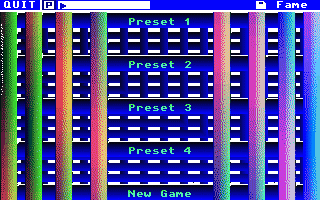
What you are seeing here is the best remap I could make of a HAM picture, now in GIF form. This is the game's main screen, and yes, it does use the HAM mode. There are well over 1000 colors on that screen, and the effect is enhanced by an interesting use of palette cycling.
What you see here is fairly self-explanatory: Quit, Pause, Saved Games, High Scores, and then either Preset or New (random) games.
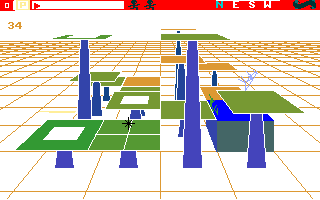
This is the first phase of the game. You are looking at part of your mind (hmm...that explains a few things). It is a 3-dimensional arena of surfaces of four different kinds, shown in small parts...in other words, if you use the joystick to move to the edge of the visible area, the game renders the next square area in your screen. The mind, as it turns out, is VERY large. Here, you can manipulate one of four different types of characters, each of whom can "use" a different terrain type. At any time, you can view a large area of the mind as a 2-dimensional array by clicking the "scroll" icon in the upper right corner of the screen. The reason you don't see my character is apparently because it's a sprite that doesn't show up in the bitplanes.
Of course, things don't always go smoothly. Your opponents are "bad thoughts," indicated by gray balls or skull-and-crossbones floating around the screen, shooting slow-moving beams of poison at you. You can fight back, however, with a truly awesome apparatus known as the Fractal Ray, which appears as bolts of lightning on the screen. Only the balls can be killed, though...
By "use," I mean to trace what is known as a "path of coherent thought," indicated by black squares being drawn into the middle of each block of terrain. You can imagine things would get fairly complex if you had to trace a path over a variety of terrain types...doing so necessitates switching characters, which can be done in special squares. The first preset, however, doesn't make you use different terrain types. Anyway, the point is to trace a contiguous path from the opening crystal square to the final flashing square. When you do so, this is what you get:
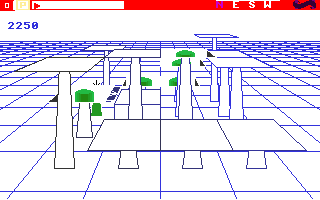
When you successfully trace a path, the entire surface of the mind within an area denoted on the map by a large diamond becomes completely black, and there are no "bad thoughts" within that area. Also at that point, what before looked like large tubes rising out of the squares open up like trap doors. You then must enter one...
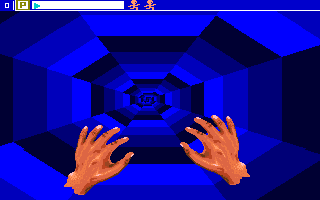
Here, you begin falling down a tube which achieves animation effects through color cycling. Green panels float towards you, and you must maneuver within the tube, as you fall, into one of them to reach the next stage. If not, you just reach the bottom and return to the mind, from which you can go down the tube again; I don't see any problem with that, although it might affect your score. When you finally get through the tube, you find yourself...
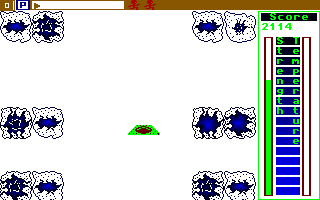
This stage is more tangible than the mind; you see neurons, and viruses, and must find a crystal which contains some of the shards of your sanity. The viruses will attack you, and slowly sap the life out of your character; you, in turn, can kill them with an interesting rotating energy-shield that fully energizes at the press of a joystick button. The truly fascinating part of this stage, though, is that you are guided by sound; there is a constant, beating rhythm in the background in the brain, and its frequency is determined by your proximity to your objective. First you must find the crystal, and then you must return to the tube.

Somehow, it always comes back to medical care...
This is where you view the seven shards of your sanity and try to put them in the proper order in the square on the left. Hard to do? Why, yes. Especially since you start with so few of the many that are needed to fill it. So if you need help, click on the pipe gadgets surrounding the good doctor, and they will fire beams up to where your tiles are stored; a tile will then be transported, in full animation, to its proper location in the square You have to time it right, though, as those rectangles between the shards and you are cycling with only one "permeable" block in the group. It's apparently not good for one reason or another to have the psychiatrist help you too much, but I've seen no evidence of this so far. The complete picture, incidentally, is a constantly cycling mass of color, and I've never seen it in one piece.
At the conclusion of your psychiatric session, you are transported back to the mind to trace another path of coherent thought. Of course, it won't be as easy as the first time...
I am amazed that the game turned out to be as OS-compliant as it is, but with anything this old, you've got to expect some incompabilities.
All things considered, however, Mind Walker is extremely system-friendly, especially for a game of its age. In the future, however, I think I'll play it under Amiga OS 1.3...I'm not too thrilled about getting inadvertantly picked off by those nasty little neurons...
There are several things that I find particularly remarkable or interesting about Mind Walker's graphics and sound effects.
Overall, the graphics and sound are very well-done.
Mind Walker is a true Amiga classic; it exemplified just about everything special about the hardware and OS from day one with a complex, absorbing, interesting story, and multi-layered plot.
In case anybody is wondering about the consequences of running a game originally intended for the 68000 on a 68030, I can tell you that they were largely positive. Very little about this game is actually processor-intensive (if anything, blitter- and copper-intensive), so the added speed was a welcome addition for such procedures as drawing the map or updating some display information. There were no processor incompabilities that I could see.
If you remember this game and have anything you want to say about it, feel free to contact me through e-mail. We sometimes publish responses from readers to the Amiga Gaming Retrospective.
One other interesting tidbit of information I might point out is that as I was going through the Mind Walker drawer that had been created on my hard disk as a result of the drag&drop copy operation, I found a T directory which in turn contained a file known as "ed-backup." I viewed the file, and found that it was a slightly different version of the disk's Startup-Sequence. It looks like the programmer made the tiniest oversight, leaving that file there, and over a decade later, it turns up. It gives an interesting link through history, and it reminds us that yes, computer programmers are people too. ;-)
If you have this game hidden away somewhere, I'd suggest that you take it out and give it a try again sometime. If you see it in a catalog anywhere, you should probably get it. It'll run on just about any Amiga system configuration, and it's as timeless and ageless as the Amiga itself; a true part of the platform's history and legacy.
Mind WalkerStrategy/Role-Playing/Action/Epic GameCommodore-Amiga Inc. and Synapse Software Corporation(normally, I'd give you the company's address here, but I doubt you'd be able to get through to Commodore, and I have no idea if Synapse Software Corporation still exists) | |||||||||||||||||||||||||||
| |||||||||||||||||||||||||||
SYSTEM REQUIREMENTSAmiga (256k), Amiga OS 1.1, Mouse, Joystick(Required) Powerful stereo sound surround system (Recommended) |